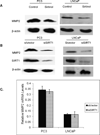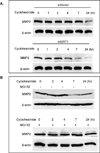SIRT1 enhances matrix metalloproteinase-2 expression and tumor cell invasion in prostate cancer cells
- PMID: 23038275
- PMCID: PMC3839321
- DOI: 10.1002/pros.22592
SIRT1 enhances matrix metalloproteinase-2 expression and tumor cell invasion in prostate cancer cells
Abstract
Background: Matrix metalloproteinase-2 (MMP2) has been shown to play an important role in cancer cell invasion and the expression of MMP2 is associated with the poor prognosis of prostate cancer; however, the mechanism of MMP2 expression is largely unknown. SIRT1 is a nicotinamide adenine dinucleotide-dependent histone deacetylase (class III HDAC) that has recently been shown to have implications in regulating cancer cell growth and apoptosis. The purpose of this study is to determine the role of SIRT1 in regulating MMP2 expression and tumor invasion in prostate cancer cells.
Methods: The interfering RNAi was used to knockdown SIRT1 from prostate cancer cells. Immunoblots, RT-PCR, zymographic assays, co-immunoprecipitation, analysis and transwell assays were used to examine the effects of SIRT1 silencing on MMP2 expression and activity, on SIRT1 and MMP2 interaction, and on prostate cancer cell invasion. The immuno-histochemical assay was performed to study SIRT1 expression in prostate cancer tissues.
Results: We show that SIRT1 associates and deacetylates MMP2 and SIRT1 regulates MMP2 expression by controlling MMP2 protein stability through the proteosomal pathway. Thus, we demonstrated a novel mechanism in that MMP2 expression can be regulated at the posttranslational level by SIRT1. Furthermore, we determined that SIRT1 inhibition reduced prostate cancer cell invasion and SIRT1 is highly expressed in advanced prostate cancer tissues.
Conclusions: SIRT1 is an important regulator of MMP2 expression, activity, and prostate cancer cell invasion. Overexpressed SIRT1 in advanced prostate cancer may play an important role in prostate cancer progression.
Copyright © 2012 Wiley Periodicals, Inc.
Figures





Similar articles
-
Estrogens promote invasion of prostate cancer cells in a paracrine manner through up-regulation of matrix metalloproteinase 2 in prostatic stromal cells.Endocrinology. 2011 Mar;152(3):773-81. doi: 10.1210/en.2010-1239. Epub 2011 Jan 19. Endocrinology. 2011. PMID: 21248144
-
Inhibition of cortactin and SIRT1 expression attenuates migration and invasion of prostate cancer DU145 cells.Int J Urol. 2012 Jan;19(1):71-9. doi: 10.1111/j.1442-2042.2011.02888.x. Epub 2011 Nov 3. Int J Urol. 2012. PMID: 22050448
-
Crude extract of Euphorbia formosana inhibits the migration and invasion of DU145 human prostate cancer cells: The role of matrix metalloproteinase-2/9 inhibition via the MAPK signaling pathway.Mol Med Rep. 2013 May;7(5):1403-8. doi: 10.3892/mmr.2013.1380. Epub 2013 Mar 20. Mol Med Rep. 2013. PMID: 23525212
-
The Role of SIRT1 on DNA Damage Response and Epigenetic Alterations in Cancer.Int J Mol Sci. 2019 Jun 28;20(13):3153. doi: 10.3390/ijms20133153. Int J Mol Sci. 2019. PMID: 31261609 Free PMC article. Review.
-
Recent advances of SIRT1 and implications in chemotherapeutics resistance in cancer.Am J Cancer Res. 2021 Nov 15;11(11):5233-5248. eCollection 2021. Am J Cancer Res. 2021. PMID: 34873458 Free PMC article. Review.
Cited by
-
The Mechanistic Roles of Sirtuins in Breast and Prostate Cancer.Cancers (Basel). 2022 Oct 19;14(20):5118. doi: 10.3390/cancers14205118. Cancers (Basel). 2022. PMID: 36291902 Free PMC article. Review.
-
Ectopic expression of miR-494 inhibited the proliferation, invasion and chemoresistance of pancreatic cancer by regulating SIRT1 and c-Myc.Gene Ther. 2015 Sep;22(9):729-38. doi: 10.1038/gt.2015.39. Epub 2015 Apr 28. Gene Ther. 2015. PMID: 25965392
-
Bioinformatic Analysis of the Effect of the Sirtuin Family on Differentiated Thyroid Carcinoma.Biomed Res Int. 2022 Jan 30;2022:5794118. doi: 10.1155/2022/5794118. eCollection 2022. Biomed Res Int. 2022. PMID: 35136826 Free PMC article.
-
Hydroxygenkwanin Inhibits Class I HDAC Expression and Synergistically Enhances the Antitumor Activity of Sorafenib in Liver Cancer Cells.Front Oncol. 2020 Feb 25;10:216. doi: 10.3389/fonc.2020.00216. eCollection 2020. Front Oncol. 2020. PMID: 32158695 Free PMC article.
-
In Vitro and In Silico Evaluation of the Potential Anti-Prostate Cancer Activity of Rosmarinus officinalis L. Leaf Extracts.Int J Mol Sci. 2025 May 13;26(10):4650. doi: 10.3390/ijms26104650. Int J Mol Sci. 2025. PMID: 40429793 Free PMC article.
References
-
- Jemal A, Siegel R, Ward E, Hao YP, Xu JQ, Thun MJ. Cancer Statistics, 2009. CA Cancer Journal for Clinicians. 2009;59(4):225–249. - PubMed
-
- Scher HI, Heller G. Clinical states in prostate cancer: Toward a dynamic model of disease progression. Urology. 2000;55(3):323–327. - PubMed
-
- Dehm SM, Tindall DJ. Molecular regulation of androgen action in prostate cancer. Journal of Cellular Biochemistry. 2006;99(2):333–344. - PubMed
-
- Busby JE, Kim SJ, Yazici S, Nakamura T, Kim JS, He J, Maya M, Wang X, Do KA, Fan D, Fidler IJ. Therapy of multidrug resistant human prostate tumors in the prostate of nude mice by simultaneous targeting of the epidermal growth factor receptor and vascular endothelial growth factor receptor on tumor-associated endothelial cells. The Prostate. 2006;66(16):1788–1798. - PubMed
Publication types
MeSH terms
Substances
Grants and funding
LinkOut - more resources
Full Text Sources
Other Literature Sources
Medical
Miscellaneous

